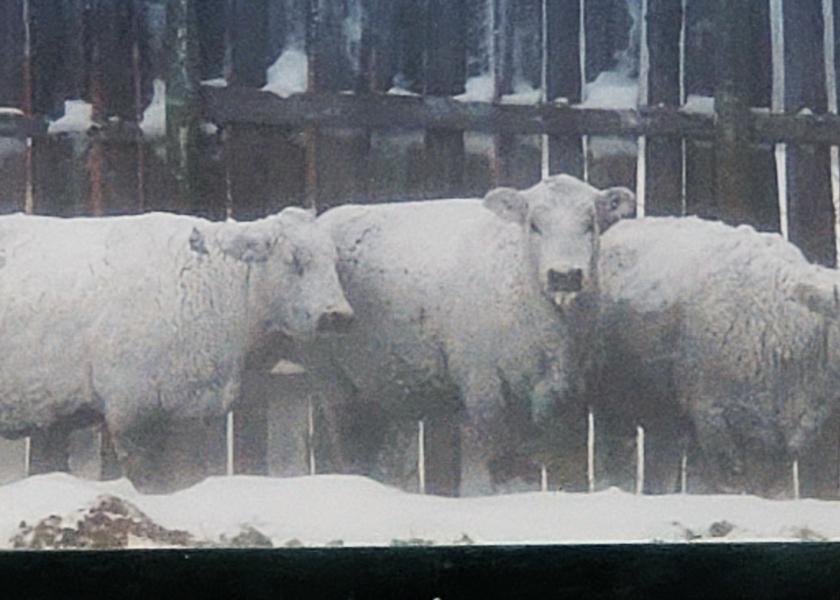Document Livestock Death Losses Due to Adverse Weather

Deep snow and blizzards are challenging ranchers and their livestock. Inclement weather can cause newborn calves and other livestock to become smothered, trampled and die. These death losses can create an emotional and financial burden for livestock producers.
North Dakota State University Extension specialists encourage ranchers to inquire about the Livestock Indemnity Program provided by the U.S. Department of Agriculture Farm Service Agency (FSA).
“The Livestock Indemnity Program provides benefits to agricultural producers for livestock deaths in excess of normal mortality caused by adverse weather, disease or by attacks by animals reintroduced into the wild by the federal government,” says Karl Hoppe, NDSU Extension livestock systems specialist at the Carrington Research Extension Center. “Eligible weather events include earthquake, hail, lightning, tornado, hurricane, flood, blizzard, wildfire, extreme heat, extreme cold, straight-line winds and eligible winter storms.”
The Livestock Indemnity Program applies to the loss of cattle, poultry, swine, sheep, horses, goats, bison and other eligible livestock.
A fact sheet for the livestock indemnity program is available on the FSA website. Search online for “FSA Livestock Indemnity Program.”
The fact sheet identifies eligible livestock, eligible loss conditions, payment rates, how to file for the Livestock Indemnity Program and loss documentation.
“Ranchers must file a notice of loss with the FSA within 30 days of when the loss is apparent,” says Hoppe. “They also must file an application for payment no later than 60 calendar days after the end of the calendar year in which the eligible loss occurred.”
The Livestock Indemnity Program requires a deduction for normal mortality and these need to be documented, he adds. These normal mortalities do not have to be weather related.
The normal morality rates for cattle in North Dakota are:
- Calves weighing less than 400 pounds – 4.6%
- Calves weighing 400 to 799 pounds – 1.5%
- Calves weighing 800 pounds or more – 1%
- Adult cows – 1.6%
- Adult bulls – 2%
Hoppe advises ranchers to contact their local FSA office for Livestock Indemnity Program details and requirements as soon as possible so the proper records may be collected. These may include photos with time and date of dead livestock and/or a veterinarian’s death certificate.
How to dispose of dead livestock
“If you experienced livestock deaths due to blizzard conditions, disposing of those carcasses will be one of your top priorities in the coming days,” says Mary Keena, NDSU Extension livestock environmental management specialist at the Carrington Research Extension Center.
In North Dakota, animals that die for any reason must be disposed of in an approved method within 36 hours of death, says Keena. Rendering, incineration, burial, composting and landfilling are all approved methods of carcass disposal. Burning is also an approved method in certain situations but should be used as a last resort.
Due to the current weather conditions, landfilling and composting may be the easiest options for carcass disposal.
“If you are going to bury, be sure carcasses are placed 4 feet above the water table with 4 feet of cover,” says Keena. “If possible, bury livestock in clay soils.”
Dispose of carcasses at an approved municipal solid waste landfill. Search “DEQ ND municipal solid waste landfills” to find an approved landfill. Contact the landfill to determine disposal protocols.
Composting is an above-ground burial process that uses resources already on your operation.
The materials you will need include:
- Base material: straw, old hay, coarse crop residues (corn stalks), sunflower hulls
- Bulking material: manure or spoiled fermented feedstuffs
- Cover material: straw, old hay, sawdust
To compost:
- Step 1: Place 2 feet of base material in pile or long row, depending on number of dead livestock to be composted.
- Step 2: Lay dead livestock on top of base. Have at least 1 foot of base material between perimeter of dead livestock and edge of base.
- Step 3: Cover dead livestock with 8 to 10 inches of bulking material.
- Step 4: Cover the entire pile or long row with 2 feet of cover material.
Things to remember:
- Small-sized dead livestock (livestock you can lift by hand) can be layered next to or stacked on top of one another, given there is bulking material between them so they are not touching.
- If composting ruminants, puncture the rumen to prevent it from exploding.
- Make sure the pile always has sufficient cover material to keep bulking material and dead livestock covered.
- Aerate the compost every six months from early spring to late fall. To accelerate composting, aerate it every two months from early spring to late fall.
- Existing compost can be used to cover new piles or long rows.







